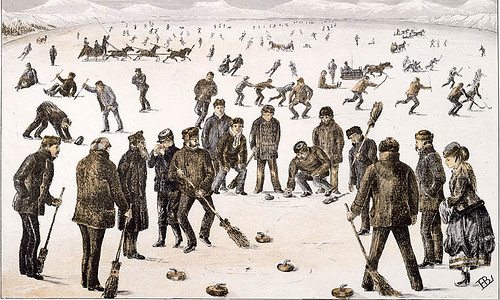#LoveCurling: Sweeping us off our feet since 1833
The Sochi games came to a dramatic close last Sunday, with Team GB matching their all-time best medal haul since 1924. Lizzie Yarnold was our gold medal favourite in the skeleton, and succeeded in keeping Team GB’s Olympic crown, won by Amy Williams in 2010.
A more surprising medal came from Jenny Jones, winning bronze in the snowboarding slope style – a sport only introduced to the Winter Games this year. However, Team GB pulled another big surprise out the bag, winning medals in both the men’s and women’s events. Curling, a sport you probably won’t find featured on television outside of the Olympics, took the nation by storm thanks to the fabulous performances of our athletes.
With our mild winters and distinct lack of snow, you can forgive our winter Olympians for missing out on the medals. However, despite Canada’s domination in the sport, curling was invented right here in Great Britain. Though there are depictions of the sport being played on lochs in Scotland as early as 1540, the first rules were drawn up in Edinburgh in 1833. Perhaps this historic link to Scotland is the reason why every curler representing Team GB has a distinctly Scottish heritage.
Though the sport can look a little baffling, the rules are quite simple: the team with the stone closest to the centre of the house (the target on the ice) gets a point for every stone closer than the opposing team’s closest stone. The game is made up of 10 ends where each team plays 8 stones. This means that there is a great deal of strategy involved, and it’s hard for amateur fans to know what’s a good shot and what spells disaster.
The most important thing to know is that the team going last has the advantage (known as ‘having the hammer’). You keep the hammer until you get some points, at which point the hammer passes over to the other team. Teams may ‘blank’ an end (hit all of the stones out of play) on purpose so that they get to keep the hammer, which can be useful if you’re either facing a risky shot to score points, or about the enter the final end.
But why all of the sweeping? What can a broom possibly do to alter the course of the stone? The ice is actually sprayed with water droplets before the match, increasing the friction on the bottom of the granite stone. Sweeping the ice can both speed the stone up and direct it. This is the ‘curling’ from which the sport gets its name.
In the game also known as ‘chess on ice’, Team GB performed outstandingly, showing that they had the strategy and determination to get up on the podium. #LoveCurling , a hashtag set up by the BBC during the games, trended several times during GB’s matches, and the British public gathered together to watch the women win Bronze and the men win Silver last week. Social media was flooded with praise and congratulation for our curlers, athletes who had been largely forgotten in the run up to the games, but who have now become beacons of Olympic success for the next generation.
Do I think we’ll turn on BBC sport after the Olympics to see our athletes sweeping the ice? Probably not. However, I do think that we’ll see kids picking up brooms and granite and having a go. Jenny Jones’ bronze medal performance has seen dry ski slopes all over the country run out of kit to deal with demand. I predict that by the time we reach PyeongChang in 2018, British curling will be of an even higher standard. Team GB’s curlers have truly inspired a generation.

Comments